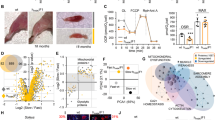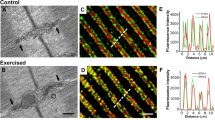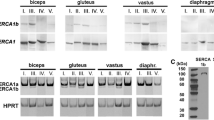Abstract
Tubular aggregates (TAs), ordered arrays of elongated sarcoplasmic reticulum (SR) tubules, are present in skeletal muscle from patients with myopathies and are also experimentally induced by extreme anoxia. In wild-type mice TAs develop in a clear age-, sex- (male), and fiber type- (fast twitch) dependence. However, the events preceding the appearance of TAs have not been explored. We investigated the sequential stages leading to the initial appearance and maturation of TAs in EDL from male mice. TAs’ formation requires two temporally distinct steps that operate via different mechanisms. Initially (before 1 year of age), the SR Ca2+ binding protein calsequestrin (CASQ) accumulates specifically at the I band level causing swelling of free SR cisternae. In the second stage, the enlarged SR sacs at the I band level extend into multiple, longitudinally oriented tubules with a full complement of sarco(endo)plasmic reticulum Ca2+ ATPases (SERCA) in the membrane and CASQ in the lumen. Tubules gradually acquire a regular cylindrical shape and uniform size apparently in concert with partial crystallization of SERCA. Multiple, small TAs associate to form fewer mature TAs of very large size. Interestingly, in fibers from CASQ1-knockout mice abnormal aggregates of SR tubules have different conformation and never develop into ordered aggregates of straight cylinders, possibly due to lack of CASQ accumulation. We conclude that TAs do not arise abruptly but are the final result of a gradually changing SR architecture and we suggest that the crystalline ATPase within the aggregates may be inactive.







Similar content being viewed by others
Abbreviations
- TAs:
-
Tubular aggregates
- CRUs:
-
Calcium release units
- EM:
-
Electron microscopy
- CASQ:
-
Calsequestrin
- SR:
-
Sarcoplasmic reticulum
- jSR:
-
Junctional SR
- TT:
-
T-tubule transverse tubule
- SERCAs:
-
Sarco(endo)plasmic reticulum Ca2+ ATPases
- DHPR:
-
Dihydropyridine receptor
- RYRs:
-
Ryanodine receptors
- WT:
-
Wild type
- CM:
-
Confocal microscopy
References
Agbulut O, Destombes J, Thiesson D, Butler-Browne G (2000) Age-related appearance of tubular aggregates in the skeletal muscle of almost all male inbred mice. Histochem Cell Biol 114(6):477–481
Airey JA, Beck CF, Murakami K, Tanksley SJ, Deerinck TJ, Ellisman MH, Sutko JL (1990) Identification and localization of two triad junctional foot protein isoforms in mature avian fast-twitch skeletal muscle. J Biol Chem 265:14187–14194
Augusto V, Padovani CR, Campos GER (2004) Skeletal muscle fiber types in c57bl6j mice. Braz J morphol Sci 21(2):89–94
Boncompagni S, d’Amelio L, Fulle S, Fano G, Protasi F (2006) Progressive disorganization of the excitation-contraction coupling apparatus in aging human skeletal muscle as revealed by electron microscopy: A possible role in the decline of muscle performance. J Gerontol A Biol Sci Med Sci 61(10):995–1008
Boncompagni S, Loy RE, Dirksen RT, Franzini-Armstrong C (2010) The I4895T mutation in the type 1 ryanodine receptor induces fiber-type specific alterations in skeletal muscle that mimic premature aging. Aging Cell 9(6):958–970
Campbell KP, Franzini-Armstrong C, Shamoo AE (1980) Further characterization of light and heavy sarcoplasmic reticulum vesicles. Identification of the ‘sarcoplasmic reticulum feet’ associated with heavy sarcoplasmic reticulum vesicles. Biochim Biophys Acta 602(1):97–116
Castellani L, Hardwicke PM, Franzini-Armstrong C (1989) Effect of ca2+ on the dimeric structure of scallop sarcoplasmic reticulum. J Cell Biol 108(2):511–520
Chevessier F, Marty I, Paturneau-Jouas M, Hantai D, Verdiere-Sahuque M (2004) Tubular aggregates are from whole sarcoplasmic reticulum origin: Alterations in calcium binding protein expression in mouse skeletal muscle during aging. Neuromuscul Disord 14(3):208–216
Chevessier F, Bauché-Godard S, Leroy JP, Koenig J, Paturneau-Jouas M, Eymard B, Hantaï D, Verdière-Sahuqué M (2005) The origin of tubular aggregates in human myopathies. J Pathol 207(3):313–323
Craig ID, Allen IV (1980) Tubular aggregates in murine dystrophy heterozygotes. Muscle Nerve 3(2):134–140
D’Incecco A, Dainese M, Protasi F, Boncompagni S (2010) Progressive triad-mitochondria un-coupling in aging. Biophys J 98:A547
Danieli-Betto D, Esposito A, Germinario E, Sandona D, Martinello T, Jakubiec-Puka A, Biral D, Betto R (2005) Deficiency of alpha-sarcoglycan differently affects fast- and slow-twitch skeletal muscles. Am J Physiol Regul Integr Comp Physiol 289(5):R1328–1337
Dux L, Martonosi A (1983) The regulation of atpase-atpase interactions in sarcoplasmic reticulum membrane. Ii. The influence of membrane potential. J Biol Chem 258(19):11903–11907
Engel WK (1964) Mitochondrial aggregates in muscle disease. J Histochem Cytochem 12:46–48
Engel WK, Bishop DW, Cunningham GG (1970) Tubular aggregates in type ii muscle fibers: Ultrastructural and histochemical correlation. J Ultrastruct Res 31(5–6):507–525
Ferguson DG, Franzini-Armstrong C, Castellani L, Hardwicke PM, Kenney LJ (1985) Ordered arrays of ca2 + -atpase on the cytoplasmic surface of isolated sarcoplasmic reticulum. Biophys J 48(4):597–605
Franzini-Armstrong C, Ferguson DG (1985) Density and disposition of ca2 + -atpase in sarcoplasmic reticulum membrane as determined by shadowing techniques. Biophys J 48(4):607–615
Fraysse B, Desaphy JF, Rolland JF, Pierno S, Liantonio A, Giannuzzi V, Camerino C, Didonna MP, Cocchi D, De Luca A, Conte Camerino D (2006) Fiber type-related changes in rat skeletal muscle calcium homeostasis during aging and restoration by growth hormone. Neurobiol Dis 21(2):372–380
Hughes SM, Chi MM, Lowry OH, Gundersen K (1999) Myogenin induces a shift of enzyme activity from glycolytic to oxidative metabolism in muscles of transgenic mice. J Cell Biol 145(3):633–642
Jones LR, Suzuki YJ, Wang W, Kobayashi YM, Ramesh V, Franzini-Armstrong C, Cleemann L, Morad M (1998) Regulation of Ca2_ signaling in transgenic mouse cardiac myocytes overexpressing calsequestrin. J Clin Invest 101:1385–1393.
Lange S, Ouyang K, Meyer G, Cui L, Cheng H, Lieber RL, Chen J (2009) Obscurin determines the architecture of the longitudinal sarcoplasmic reticulum. J Cell Sci 122(Pt 15):2640–2650
Meissner G, Conner GE, Fleischer S (1973) Isolation of sarcoplasmic reticulum by zonal centrifugation and purification of ca 2+ -pump and ca 2+ -binding proteins. Biochim Biophys Acta 298(2):246–269
Morgan-Hughes JA (1998) Tubular aggregates in skeletal muscle: Their functional significance and mechanisms of pathogenesis. Curr Opin Neurol 11(5):439–442
Muller HD, Vielhaber S, Brunn A, Schroder JM (2001) Dominantly inherited myopathy with novel tubular aggregates containing 1–21 tubulofilamentous structures. Acta Neuropathol 102(1):27–35
Niakan E, Harati Y, Danon MJ (1985) Tubular aggregates: Their association with myalgia. J Neurol Neurosurg Psychiatry 48(9):882–886
Nishikawa T, Takahashi JA, Matsushita T, Ohnishi K, Higuchi K, Hashimoto N, Hosokawa M (2000) Tubular aggregates in the skeletal muscle of the senescence-accelerated mouse; sam. Mech Ageing Dev 114(2):89–99
Novotova M, Zahradnik I, Brochier G, Pavlovicova M, Bigard X, Ventura-Clapier R (2002) Joint participation of mitochondria and sarcoplasmic reticulum in the formation of tubular aggregates in gastrocnemius muscle of ck-/- mice. Eur J Cell Biol 81(2):101–106
Paolini C, Protasi F, Franzini-Armstrong C (2004) The relative position of ryr feet and dhpr tetrads in skeletal muscle. J Mol Biol 342(1):145–153
Paolini C, Quarta M, Nori A, Boncompagni S, Canato M, Volpe P, Allen PD, Reggiani C, Protasi F (2007) Reorganized stores and impaired calcium handling in skeletal muscle of mice lacking calsequestrin-1. J Physiol 583(Pt 2):767–784
Pavlovicova M, Novotova M, Zahradnik I (2003) Structure and composition of tubular aggregates of skeletal muscle fibres. Gen Physiol Biophys 22(4):425–440
Pierobon-Bormioli S, Armani M, Ringel SP, Angelini C, Vergani L, Betto R, Salviati G (1985) Familial neuromuscular disease with tubular aggregates. Muscle Nerve 8(4):291–298
Rosenberg NL, Neville HE, Ringel SP (1985) Tubular aggregates. Their association with neuromuscular diseases, including the syndrome of myalgias/cramps. Arch Neurol 42(10):973–976
Salviati G, Pierobon-Bormioli S, Betto R, Damiani E, Angelini C, Ringel SP, Salvatori S, Margreth A (1985) Tubular aggregates: sarcoplasmic reticulum origin, calcium storage ability, and functional implications. Muscle Nerve 8(4):299–306
Sato Y, Ferguson DG, Sako H, Dorn GW 2nd, Kadambi VJ, Yatani A, Hoit BD, Walsh RA, Kranias EG (1998) Cardiac-specific overexpression of mouse cardiac calsequestrin is associated with depressed cardiovascular function and hypertrophy in transgenic mice. J Biol Chem 273(43):28470–28477
Schiaffino S, Severin E, Cantini M, Sartore S (1977) Tubular aggregates induced by anoxia in isolated rat skeletal muscle. Lab Invest 37(3):223–228
Schubert W, Sotgia F, Cohen AW, Capozza F, Bonuccelli G, Bruno C, Minetti C, Bonilla E, Dimauro S, Lisanti MP (2007) Caveolin-1(-/-)- and caveolin-2(-/-)-deficient mice both display numerous skeletal muscle abnormalities, with tubular aggregate formation. Am J Pathol 170(1):316–333
Tijskens P, Jones LR, Franzini-Armstrong C (2003) Junctin and calsequestrin overexpression in cardiac muscle: The role of junctin and the synthetic and delivery pathways for the two proteins. J Mol Cell Cardiol 35(8):961–974
Tomasi M, Canato M, Paolini C, Dainese M, Reggiani C, Protasi F, Volpe P, Nori A (2009) Expression of calsequestrin-1 (cs1) in cs1-null mice: restoration of calcium release unit architecture and amplitude of calcium transient in fast-twitch muscle fibers. Biophys J 96(3):236a–237a
Toyoshima C, Nomura H, Tsuda T (2004) Lumenal gating mechanism revealed in calcium pump crystal structures with phosphate analogues. Nature 432(7015):361–368
Vassilopoulos S, Thevenon D, Rezgui SS, Brocard J, Chapel A, Lacampagne A, Lunardi J, Dewaard M, Marty I (2005) Triadins are not triad-specific proteins: Two new skeletal muscle triadins possibly involved in the architecture of sarcoplasmic reticulum. J Biol Chem 280(31):28601–28609
Vielhaber S, Schroder R, Winkler K, Weis S, Sailer M, Feistner H, Heinze HJ, Schroder JM, Kunz WS (2001) Defective mitochondrial oxidative phosphorylation in myopathies with tubular aggregates originating from sarcoplasmic reticulum. J Neuropathol Exp Neurol 60(11):1032–1040
Wang CT, Saito A, Fleischer S (1979) Correlation of ultrastructure of reconstituted sarcoplasmic reticulum membrane vesicles with variation in phospholipid to protein ratio. J Biol Chem 254(18):9209–9219
Yoshitoshi M, Ishihara T, Yoshimura Y, Tsugane T, Shinohara Y (1991) the effect of sex hormones on tubular aggregates in normal mouse skeletal muscles. Rinsho Shinkeigaku 31(9):974–980
Acknowledgements
We thank Drs. Osvaldo Delbono and Cecilia Paolini for providing samples of aged female mice and CASQ1 null mice used in this study. We thank L. R. Jones (Indiana University) for the generous gift of anti CASQ antibody 4B1.D3. This study was supported by National Institutes of Health Grant 5P01AR052354 to C.F.A. and by Telethon Research Grant GGP08153 to F.P.
Author information
Authors and Affiliations
Corresponding author
About this article
Cite this article
Boncompagni, S., Protasi, F. & Franzini-Armstrong, C. Sequential stages in the age-dependent gradual formation and accumulation of tubular aggregates in fast twitch muscle fibers: SERCA and calsequestrin involvement. AGE 34, 27–41 (2012). https://doi.org/10.1007/s11357-011-9211-y
Received:
Accepted:
Published:
Issue Date:
DOI: https://doi.org/10.1007/s11357-011-9211-y




